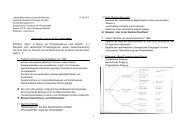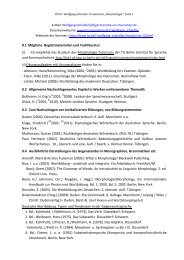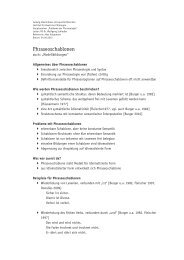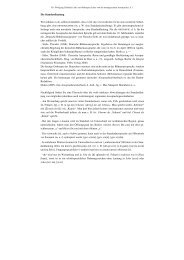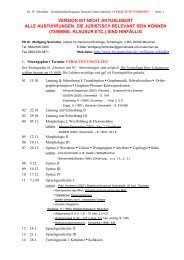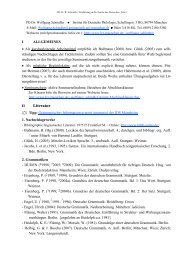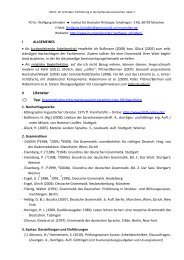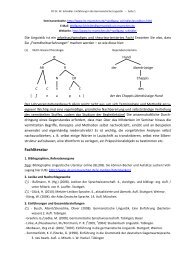Chapter 18 Lexical Functions: Description of Lexical Relations in a ...
Chapter 18 Lexical Functions: Description of Lexical Relations in a ...
Chapter 18 Lexical Functions: Description of Lexical Relations in a ...
You also want an ePaper? Increase the reach of your titles
YUMPU automatically turns print PDFs into web optimized ePapers that Google loves.
—<strong>Chapter</strong> <strong>18</strong>. <strong>Lexical</strong> <strong>Functions</strong>— 55<br />
NB: Let it be remembered that LF verbs tak<strong>in</strong>g their keyword as SSynt-Subject are quoted <strong>in</strong> the 3rd person<br />
s<strong>in</strong>gular: such is, e.g., the case <strong>of</strong> all Func; otherwise, they are <strong>in</strong> the <strong>in</strong>f<strong>in</strong>itive.<br />
is used:<br />
In case there is no object at all, i.e., Func i is an absolutely <strong>in</strong>transitive verb, the subscript 0<br />
Func 0(snowN) = falls [At night, the snow started to fall] Func 0(war) = is on<br />
Func 0(silence) = reigns Func 0(smellN) = l<strong>in</strong>gers<br />
45. Labor ijk [Lat. laborāre ([to] work, toil)] = support verb with L as 2nd Object<br />
The DSyntA I <strong>of</strong> a Labor verb (and its SSynt-Subject) is the i-th DSyntA(L), its DSyntA II<br />
(= its ma<strong>in</strong> SSynt-Object) is the j-th DSyntA <strong>of</strong> L, its DSyntA III (= its secondary SSynt-Object)<br />
is the k-th DSyntA <strong>of</strong> L, and its further DSyntA (= its tertiary SSynt-Object) is L itself.<br />
Examples<br />
Labor 12(<strong>in</strong>terrogation) = subject [NY to an <strong>in</strong>terrogation, where the keyword INTERROGATION is<br />
DSyntA III <strong>of</strong> the verb to subject]<br />
Labor 321(leaseN) = grant [NY to NZ on lease, where the keyword LEASEN is DSyntA IV <strong>of</strong><br />
the verb grant; the underly<strong>in</strong>g expression is X leases Z from Y]<br />
Rus. NASLEDSTVO (<strong>in</strong>heritance) (the underly<strong>in</strong>g expression is X nasleduet Y ot Z-a (X<br />
<strong>in</strong>herits Y from Z)) has the follow<strong>in</strong>g three Labors:<br />
Labor 123(nasledstvo) = polučit´ [N acc ot N gen v ~] lit. (receive NY from NZ <strong>in</strong> <strong>in</strong>heritance)<br />
Labor 213(nasledstvo) = dostat´sja [N dat ot N gen v ~] lit. (come to NX from NZ <strong>in</strong> <strong>in</strong>heritance)<br />
Labor 321(nasledstvo) = ostavit´ [N acc N dat v ~] lit. (leave NY to NX <strong>in</strong> <strong>in</strong>heritance)<br />
In all these examples, the phrase v nasledstvo (<strong>in</strong> <strong>in</strong>heritance) is the DSyntA IV <strong>of</strong> Labor.<br />
Oper 0/i, Func 0/i and Labor ijk<br />
can be paired <strong>in</strong> converse relations:<br />
Oper 1 = Conv 21(Func 1); Labor 12 = Conv 132(Oper 1); etc.<br />
These relations may be diagrammed—for a two-actant LU, <strong>in</strong> this case ANALYSIS—as follows:<br />
Oper 0<br />
Func 2<br />
L = ANALYSIS<br />
Func 0<br />
Oper Oper<br />
Func<br />
2<br />
1 2<br />
Labor<br />
12<br />
Labor<br />
21<br />
I = JOHN II = PHENOMENON<br />
Figure <strong>18</strong>-2<br />
Support Verbs and Their DSynt-<strong>Relations</strong>hips with their Keyword


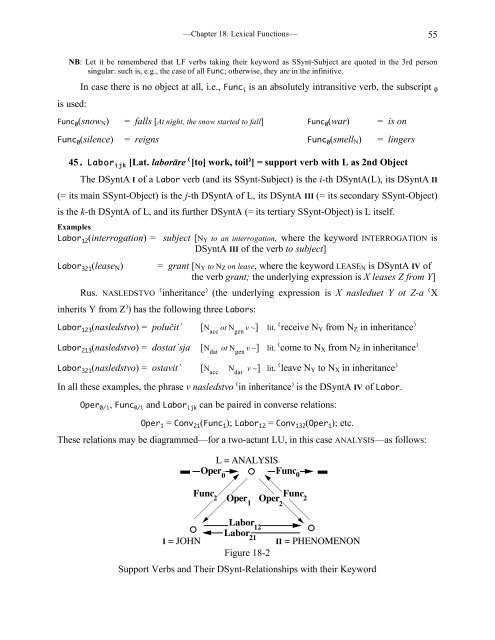
![E-Mail: Wolfgang.Schindler[ätt]germanistik.uni-muenchen.de Web ...](https://img.yumpu.com/51590147/1/184x260/e-mail-wolfgangschindlerattgermanistikuni-muenchende-web-.jpg?quality=85)
